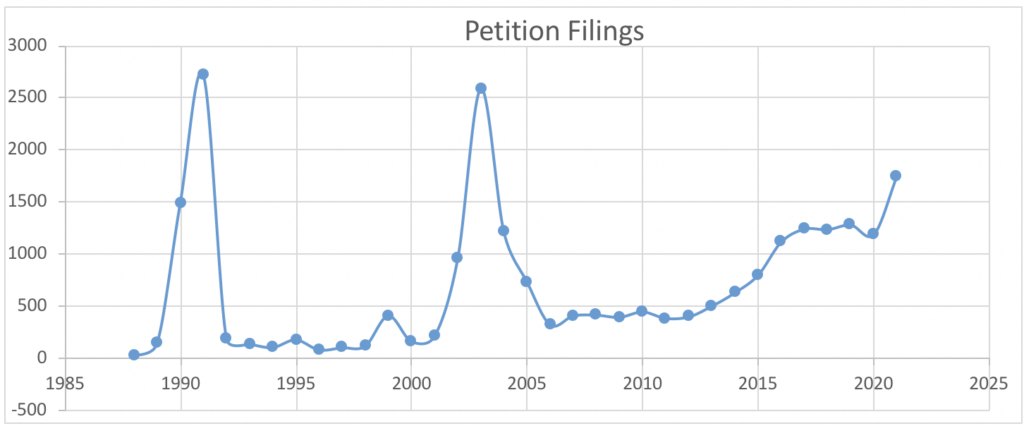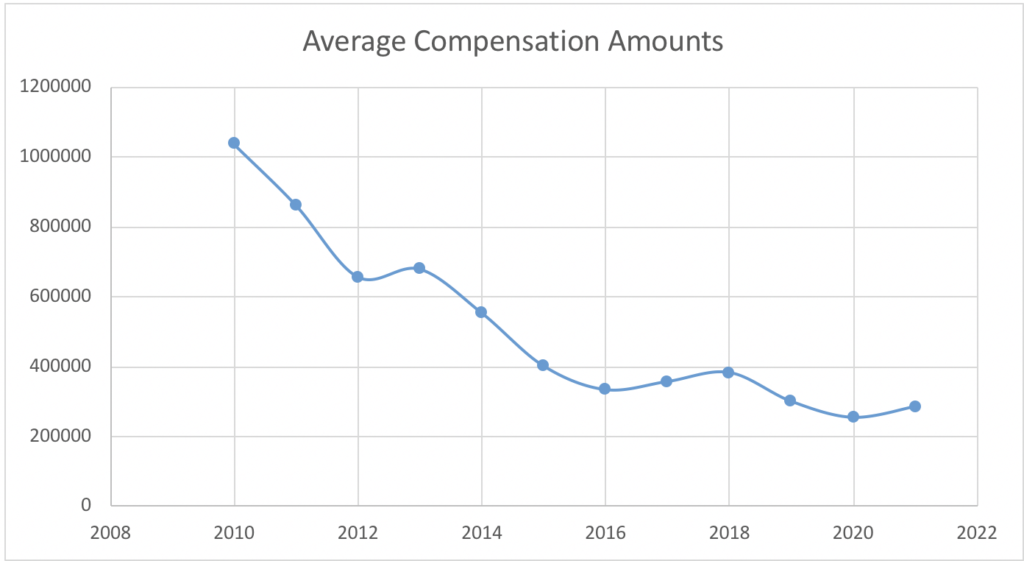Vaccine Injury: Another Milestone and Compensation Trending Downward
Updated
By Wayne Rohde
Late last summer the National Vaccine Injury Compensation Program (NVICP) reached a milestone that no one should be proud of. The total amount of compensation and fees paid out for injuries and deaths as the result of the influenza vaccine crossed the $1 Billion dollar threshold. This represents over 25% of the entire outlay from the Program was the result of injuries and deaths from the Influenza vaccine. This vaccine was only approved in 2005. I wrote about it here.
PETITION FILINGS
Now we are approaching another milestone, the total number of petitions filed in one fiscal year. The benchmark was notoriously achieved in 1991 with 2,718 filings and was nearly matched in 2003 with 2,592 filings. In 1991, the program required petitioners within a given timeframe for Hepatitis B injuries. In 1992, the petition filings dropped to 189 and remained steady until 2000.

The vast majority of 2003 petitions (2,592) were autism related. The following year, 2004, saw 1,214 filings. The 2004 figure alone, if not for 2003, could have served as the high-water mark for the next 13 years. Most years the figure was between 350-600 petitions filed.
It was not until 2017 that we see petition filings approach the 2004 figure of 1,214. And sadly, since 2017 with 1,243 filings, we are now seeing a consistent reporting of annual petitions above 1,200. This is due to the Influenza vaccine injuries such as shoulder injuries and Guillain-Barré Syndrome (GBS).
However, in the current fiscal year of 2021 which ends September 30, 2021, there is a strong possibility of breaking the 2003 mark of 2,592. It appears that if petitions continue to be submitted to HRSA seeking compensation at the same rate as the last couple of months, the new mark could be 2,600 or greater. Will it overcome the 1991 mark of 2,718? It is possible? Many petitioners filed in January and February of this year due to the proposed rule by Secretary of HHS to remove SIRVA or shoulder injury and syncope or fainting as Table injuries in the NVICP, to beat the clock of February 22, 2021.
However, since the Biden Administration has removed this proposed action, we are still witnessing large numbers of petitions being submitted. Adults are still injured in large numbers. There are a few petitions for children being filed but the vast majority are adults. Attorneys representing injured persons are busier than ever. Many attorneys in this field work 80-90+ hours per week.
COMPENSATION AWARDS
The downward trend that has gone unnoticed by many is the average compensation amount per award. The figure is compensation for the injured person, excluding attorney fees and medical expert costs. And HRSA does not publicize this figure in their monthly statistics report.
In fiscal year 2010, the average compensation was $1,036,921.05 according to HRSA records. Of course, they will not supply this figure directly. But anyone can simply divide the total amount paid out ($179,387,341.30) by the number of damage awards (173). And the $1 million dollar figure will serve as the high point for the next 11 years.
In FY2020, the average compensation stood at nearly $250,000, which is only 25% of FY2010. For this year’s amount it appears to be closer to $280,000.

Why the dramatic decrease? In my opinion there are several reasons.
- The Influenza vaccine was approved for the Program in 2005 and has become the dominate vaccine causing injuries.
- The shift from the National Vaccine Injury Compensation Program (NVICP), a children’s compensation program, to what I call the National Adult Vaccine Injury Compensation Program (NAVICP). Over 92% of all compensated petitions in FY 2019 and 2020 were adults. Adult shoulder injuries and to a lesser degree, GBS cases dominated the program.
- Policy changes within our Federal Government to protect the Vaccine Program. No more petitions such as DTaP causing early onset of seizures and epilepsy, SIDS, Autism, Gardasil causing debilitating injuries.
- Childhood vaccines are administered as multiple vaccines at one time versus adult vaccines tend to be administered one vaccine during the doctor’s office visit. Generally, it is more difficult, costly, and requires lengthy adjudication with hearings and medical experts to prosecute a petition for a child with multiple vaccines and the alleged injuries as compared to an adult case of influenza vaccine causing a shoulder injury
Next year there may be more disturbing trends to discuss that are currently forming. It is a never ending, sometimes maddening observation of a federal judicial system that has turned its back on children and their parents.
CLOSING QUESTIONS
Finally, during the last ACIP committee meeting in May 2021 there was a vote and overwhelming approval without any studies, reports or documents supporting the vote, to combine COVID vaccines and childhood vaccines during the same doctor appointment. Now if a child suffers an injury from the administration of a COVID vaccine and Gardasil, how and where does the parent go for compensation? COVID vaccine injuries currently belong in the CounterMeasures Injury Compensation Program (CICP) and Gardasil belongs in the NVICP. Can an injury petition claiming Gardasil which caused GBS be successful in the NVICP, or will our government claim the injury petition should have been prosecuted in the black hole, known as the CICP?
Wayne Rohde, author of The Vaccine Court 2.0 and The Vaccine Court-The Dark Truth of America’s Vaccine Injury Compensation Program.
Also host of Right on Point podcast, discussing your civil liberties, health freedom, legalities of possible mandates, passports, and restrictions surrounding COVID pandemic policy.











